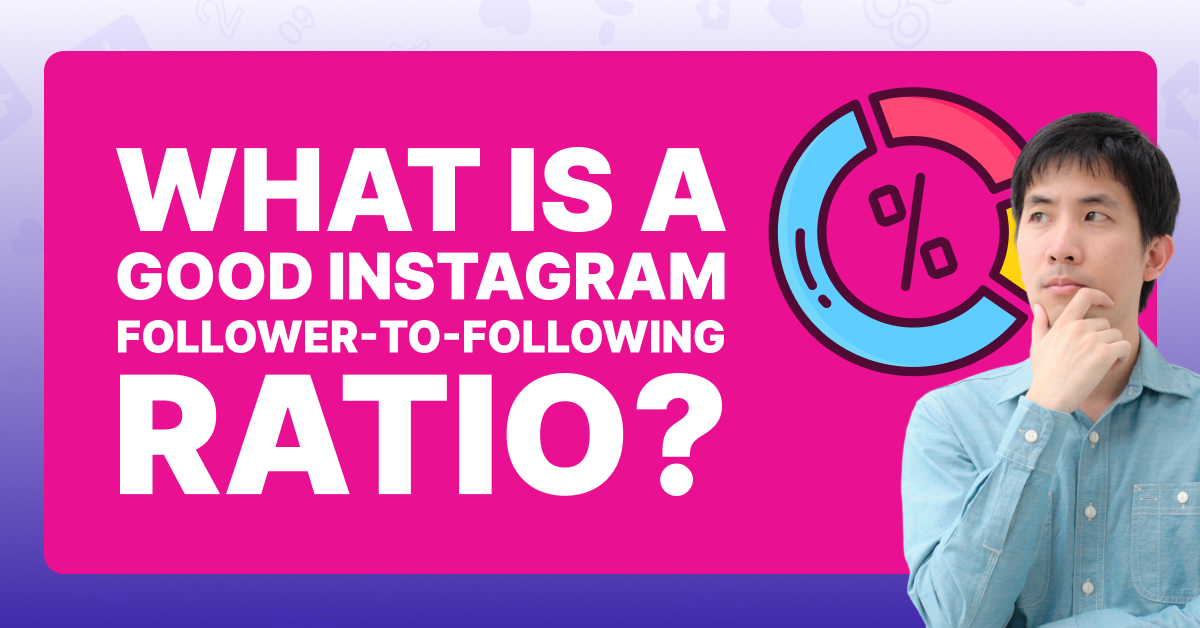Who hasn’t dreamt of becoming an Instagram sensation? We all yearn for that recognition, yet only a few achieve it. And sometimes it isn’t just about posting captivating content; it’s also about mastering the art of perception.
When it comes to Instagram, how you’re perceived can be just as important as what you post. Balancing the follower-to-following ratio is a subtle yet powerful way to enhance your social media presence, conveying selectiveness and popularity.
Understanding this can help you unlock your full potential on the platform. So are you just a few followers away from Instagram fame? Find out how your follower-to-following ratio could hold the key!
What Is A Follower To Following Ratio?
The follower-to-following ratio on social media is a simple yet revealing metric.
- A ‘follower‘ is anyone who chooses to see your content in their feed, indicating interest or support in what you post.
- ‘Following‘ represents the accounts YOU choose to follow, showing your interests and preferences.
- The ratio of these two numbers is what we call the follower-to-following ratio. This ratio matters because it shapes public perception of your social media profile.
A high ratio, where followers significantly outnumber those you follow, often paints you as an influencer or a person of interest. Conversely, a low ratio, where you follow many more accounts than follow you, might suggest spam-like behavior or a less established presence.
This ratio is a quick way to gauge how others might perceive your social media standing.
What Do Certain Follower To Following Ratios Mean?
When assessing the follower-to-following ratios on social media, it’s important to understand what these numbers suggest about an account’s standing or influence.
Intuitively, people often judge whether someone is an influencer or if a business is successful based on this ratio.
Here’s a simplified guide to interpreting these ratios:
- Less than 0.3: This may indicate a spam-like behavior, possibly engaging in follow-back schemes to artificially boost follower count. If a business account has this ratio, it’s extremely untrustworthy.
- 0.3 to 1: Suggests a regular, everyday user. The account doesn’t necessarily stand out as spammy, but it also doesn’t scream ‘influencer’.
- 1 to 2: Represents a growing account that is starting to establish a presence and garner more followers than following.
- 3 to 10: Indicates a quality account with a solid following, suggesting that the content is engaging and worth following. Very small businesses are likely to have this ratio.
- 11 to 100: This suggests a micro influencer, someone with a decent following but hasn’t reached celebrity status quite yet.
- 101 to 1000+: This is typically the range of influencers and well-established accounts, showing a significant disparity between a large follower count and a relatively smaller following count.
- 100k+: Once you’ve reached this level, you can assume the account is for a highly recognized celebrity or massive business.
These ratios offer a quick snapshot of an account’s perceived value and influence on Instagram.
How To Calculate Follower To Following Ratio?

To calculate the follower-to-following ratio, use the formula:
For example, if you have 100,000 followers and follow 1,000 accounts, your ratio is 100 (100,000 ÷ 1,000). This indicates a strong, influential presence on the platform.
On the other hand, with 100 followers and following 110 accounts, the ratio is approximately 0.91 (100 ÷ 110), suggesting a more typical, personal-use account.
Here’s a table illustrating the ratios for various accounts:
| Name | Followers | Following | Ratio |
| Mr. Beast | 49.3M | 498 | 98,996 |
| Kim Kardashian | 364M | 301 | 1,209,302 |
| Cristiano Ronaldo | 618M | 583 | 1,060,034 |
| Lewis Hamilton | 35.6M | 4 | 8,900,000 |
| Average User 1 | 100 | 300 | 0.33 |
| Average User 2 | 96 | 90 | 1.07 |
| Random Spam Account | 3 | 10,000 | 0.0003 |
This table shows how the follower-to-following ratio varies widely from popular figures to average and spam accounts.
As you can see, even though Lewis Hamilton has fewer followers compared to some other celebrities, his follower-to-following ratio is extremely high. This is because he follows a very small number of accounts.
Since the ratio is calculated by dividing the number of followers by the number of accounts followed, a small ‘following’ number can significantly amplify the ratio. Hamilton’s choice to follow only a few enhances his ratio, projecting an image of exclusivity and high selectivity in his social media interactions.
What Is A Good Follower To Following Ration For Me To Have?
Determining a good follower-to-following ratio depends on your goals and the nature of your account. If you’re aiming to establish yourself as an influencer or a public figure, a higher ratio (100+) is desirable. This means having significantly more followers than accounts you follow.
However, if your account is more personal or for casual social interaction, a balanced (1) or even a lower ratio can be perfectly acceptable.
It’s important to note that authenticity and genuine engagement often matter more than just numbers.
Why? Well because it builds meaningful connections with your audience. Unlike superficial metrics, real interactions reflect the impact and relevance of your content. Engaged followers are more likely to trust your brand, share your content, and ultimately contribute to your online presence’s growth and authenticity.
So, while keeping an eye on this ratio can be helpful, focusing on meaningful interactions and quality content is what will actually get you success.

